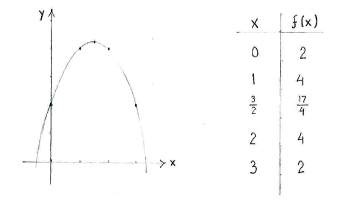Lösung 1.3:2b
Aus Online Mathematik Brückenkurs 2
(Unterschied zwischen Versionen)
| (Der Versionsvergleich bezieht 9 dazwischen liegende Versionen mit ein.) | |||
| Zeile 1: | Zeile 1: | ||
| - | + | Lokale Extremstellen einer Funktion sind entweder: | |
| - | + | # stationäre Stellen mit <math>f^{\,\prime}(x)=0</math>, | |
| - | <math> | + | # Singuläre Stellen, in denen die Funktion nicht differenzierbar ist, oder |
| - | + | # Randstellen. | |
| - | + | ||
| - | + | ||
| - | + | ||
| - | + | Wir untersuchen alle drei Fälle: | |
| - | + | <ol> | |
| - | <math>f | + | <li>Die Ableitung von <math>f(x)</math> ist |
| - | + | {{Abgesetzte Formel||<math>f^{\,\prime}(x) = 3-2x</math>}} | |
| - | + | und wird null für <math>x=3/2\,</math>.</li> | |
| - | <math> | + | |
| - | and becomes zero when | ||
| - | <math>x=\frac{3}{2}</math>. | ||
| - | + | <li>Da die Funktion ein Polynom ist, ist sie überall differenzierbar.</li> | |
| - | + | <li>Die Funktion ist überall definiert, also hat unser Intervall keine Randstellen.</li> | |
| - | < | + | </ol> |
| - | + | ||
| - | + | Also sind alle lokalen Extremstellen auch stationäre Stellen. Somit ist <math>x=3/2\,</math> die einzige Stelle, die eine Extremstelle sein könnte. Mit einer Vorzeichentabelle untersuchen wir, ob die Stelle eine Extremstelle ist. | |
| - | <math>x= | + | |
| - | If we write down a sign table for the derivative, we see that | ||
| - | <math>x=\frac{3}{2}</math> | ||
| - | is a local maximum. | ||
| - | + | {| border="1" cellpadding="5" cellspacing="0" align="center" | |
| + | |- | ||
| + | |width="50px" align="center" style="background:#efefef;"| <math>x</math> | ||
| + | |width="50px" align="center" style="background:#efefef;"| | ||
| + | |width="50px" align="center" style="background:#efefef;"| <math>\tfrac{3}{2}</math> | ||
| + | |width="50px" align="center" style="background:#efefef;"| | ||
| + | |- | ||
| + | |width="50px" align="center"| <math>f^{\,\prime}(x)</math> | ||
| + | |width="50px" align="center"| <math>+</math> | ||
| + | |width="50px" align="center"| <math>0</math> | ||
| + | |width="50px" align="center"| <math>-</math> | ||
| + | |- | ||
| + | |width="50px" align="center"| <math>f(x)</math> | ||
| + | |width="50px" align="center"| <math>\nearrow</math> | ||
| + | |width="50px" align="center"| <math>\tfrac{17}{4}</math> | ||
| + | |width="50px" align="center"| <math>\searrow</math> | ||
| + | |} | ||
| - | + | Da die Funktion eine quadratische Funktion ist, ist deren Graph eine Parabel mit dem Maximum <math> \frac{17}{4} </math> an der Stelle <math> x = \frac{3}{2} </math>. | |
| - | <math> | + | |
| - | + | ||
| - | + | [[Image:1_3_2_b.gif||center]] | |
Aktuelle Version
Lokale Extremstellen einer Funktion sind entweder:
- stationäre Stellen mit \displaystyle f^{\,\prime}(x)=0,
- Singuläre Stellen, in denen die Funktion nicht differenzierbar ist, oder
- Randstellen.
Wir untersuchen alle drei Fälle:
- Die Ableitung von \displaystyle f(x) ist
und wird null für \displaystyle x=3/2\,.\displaystyle f^{\,\prime}(x) = 3-2x - Da die Funktion ein Polynom ist, ist sie überall differenzierbar.
- Die Funktion ist überall definiert, also hat unser Intervall keine Randstellen.
Also sind alle lokalen Extremstellen auch stationäre Stellen. Somit ist \displaystyle x=3/2\, die einzige Stelle, die eine Extremstelle sein könnte. Mit einer Vorzeichentabelle untersuchen wir, ob die Stelle eine Extremstelle ist.
| \displaystyle x | \displaystyle \tfrac{3}{2} | ||
| \displaystyle f^{\,\prime}(x) | \displaystyle + | \displaystyle 0 | \displaystyle - |
| \displaystyle f(x) | \displaystyle \nearrow | \displaystyle \tfrac{17}{4} | \displaystyle \searrow |
Da die Funktion eine quadratische Funktion ist, ist deren Graph eine Parabel mit dem Maximum \displaystyle \frac{17}{4} an der Stelle \displaystyle x = \frac{3}{2} .

